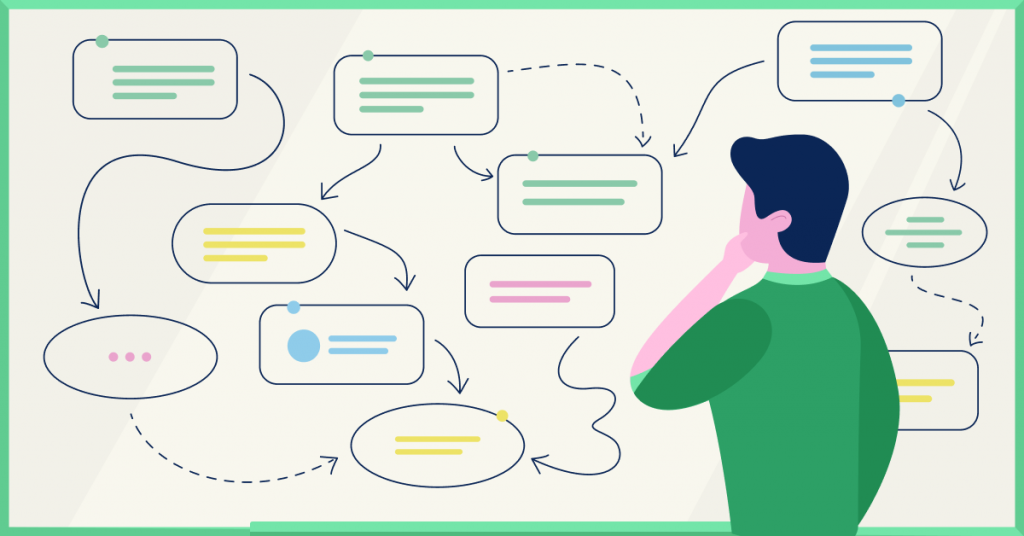
Logic Tree framework
The Logic or Decision Tree is a critical thinking framework based on root-cause analysis. The essence of the framework lies in a visual representation of a problem decomposed into small chunks.
The Decision Tree technique was first described in the 1960s as a regression tool to track back the triggering events that led to a failure. Today, the framework is applied to both decision-making and retrospective analysis of an emerged issue.
Here’s how to use it if you need to make a decision:
- Specify the problem. It’s important to make sure that you’re solving the right problem. Decide what you really need to know and if it is that important in your case.
- Think about the solutions that can work, even if they seem unrealistic. Challenge yourself to think outside the box. It can help you find a creative solution.
- Consider each option carefully, and write as many supporting and contradictory ideas as you can think of. These can be risks, opportunities, or benefits.
- Create the tree using a board, stickers, and markers to have every bit of information in front of you.
In the case of a retrospective use, the problem is considered backwards. Instead of searching for a solution, you focus on an existing problem and add aspects that caused it to the board.
Now, let’s apply the framework to solve a hypothetical problem. Imagine that you live in San Francisco and have a friend in LA whom you want to visit. There are many options you can choose as a means of transportation.
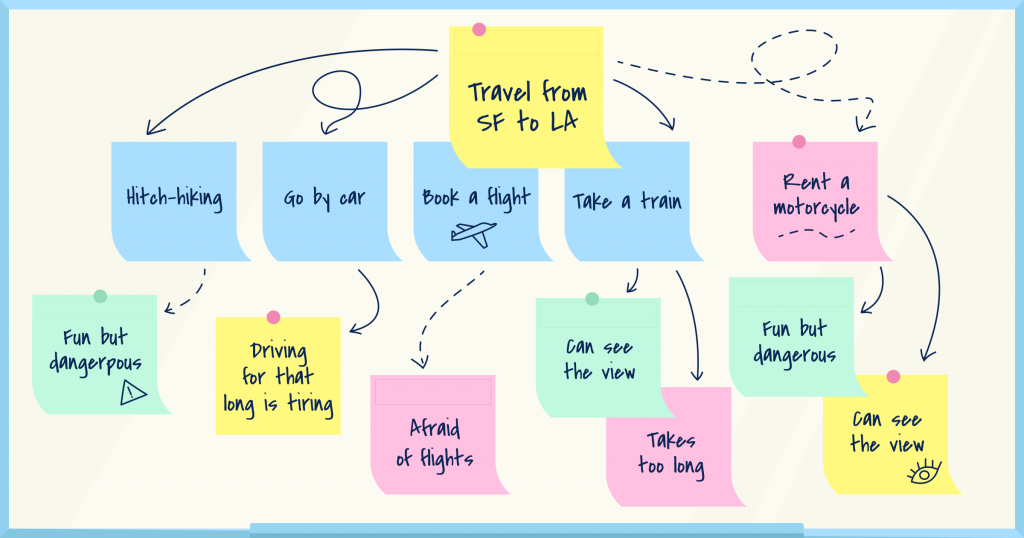
When all the ideas (even the craziest ones) are listed, you need to consider each of them separately for an in-depth context investigation. After that, compare each option and decide which is the best in the given conditions (time frames, budget, feasibility).
Please note, this decision-making framework doesn’t help you single out one option but rather helps deep dive into the context of a problem so that you can make a carefully weighed decision.
| Logic Tree advantages | Logic Tree limitations |
|---|---|
| Facilitates deep context investigation. If the context is overwhelming, you can go as deep as you need, deconstructing each component into smaller ones. | It doesn’t give you the answer. The framework aims at a deep analysis of the problem-related data. However, it doesn’t give you the answer you might need. What’s more, unlike some other frameworks we consider below, Logic Tree doesn’t provide any instruments to evaluate your choice except for your intuition and the data you were able to collect. |
| It’s easy to perceive complex context. The framework offers a simple way to visually structure context that allows managing complex information and detecting unobvious connections, dependencies, and patterns. | Unstructured flow. Despite the apparent simplicity of the framework, there’s no clear understanding of what information to dig into and how to make sure it’s relevant. |
| Allows generating lots of ideas in a short time. If used in a team, Logic Tree can be a base for a brainstorming session in cases when numerous solutions are needed. | High risk of emotional biases. If the problem you are trying to solve is personal, you may fall into a trap where all the collected data is based on your prejudices and personal attitudes. |
| Helps to think outside the box. When considering potential solutions, you can offer everything that springs to mind, even if it seems unimplementable. Later on, you can reject them anyway. This mental freedom allows you to generate a brand-new solution and see the opportunities your competitors missed. | |
| Can be applied reversibly. The framework is equally suitable for making future choices or decisions and investigating existing issues' causes. |

Decision Matrix
British product designer, Stuart Pugh, introduced a mathematical approach to ranking options with multiple characteristics (dimensions) and called it the Decision Matrix method.
Here’s a short instruction on how to apply this framework for decision-making:
- Define all the options you have. Create a table and list them in the first column.
- Choose the criteria you want to compare. List these characteristics in the first line of your table.
- Score each criterion of each option using a 3, 5, or 10-point system, for example.
- Evaluate each criterion. This way, you prioritize characteristics as they usually have different values. The easiest way would be to use the 1 – 10 system, where 1 is bad, and 10 is excellent.
- Multiply the score of each characteristic by its values.
- Add the numbers you got in each line. The option with the biggest number is the winner.
Sounds too complicated? Let’s apply the framework to the same example we used before (you want to visit your friend in LA) to see how it works in practice.
We listed all the options and criteria in our table. At that stage, we also defined the importance of each criterion. We used the five-point system. Safety, for instance, is a very important criterion (has a score of 5), while Speed can be neglected (has a score of 3).
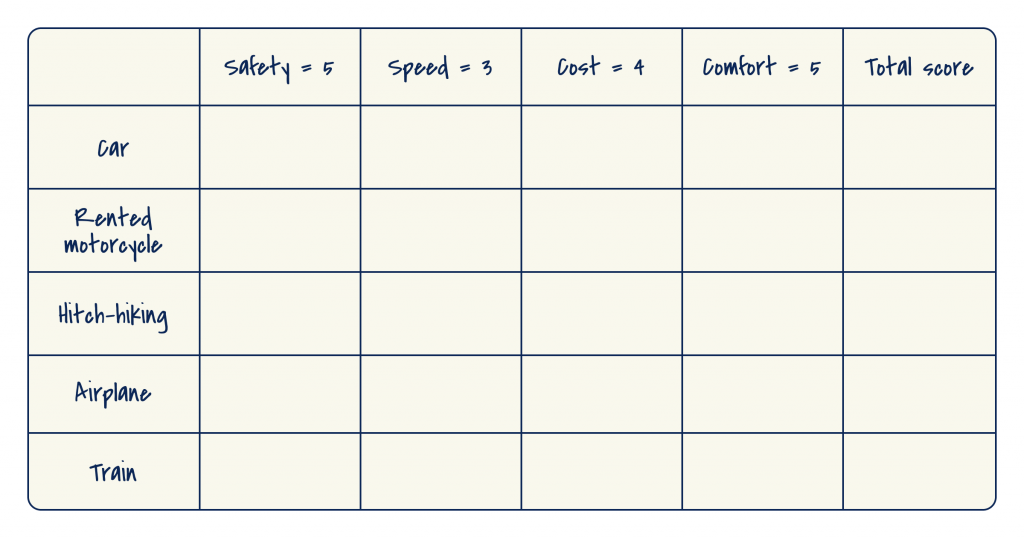
After that, we scored each option using their characteristics using the ten-point system. This way, a Car’s safety score was 8, a Motorcycle’s safety was 6, and the safety of the Hitch-hiking option was just 5.
Then, we multiplied the score of each criterion by their value.
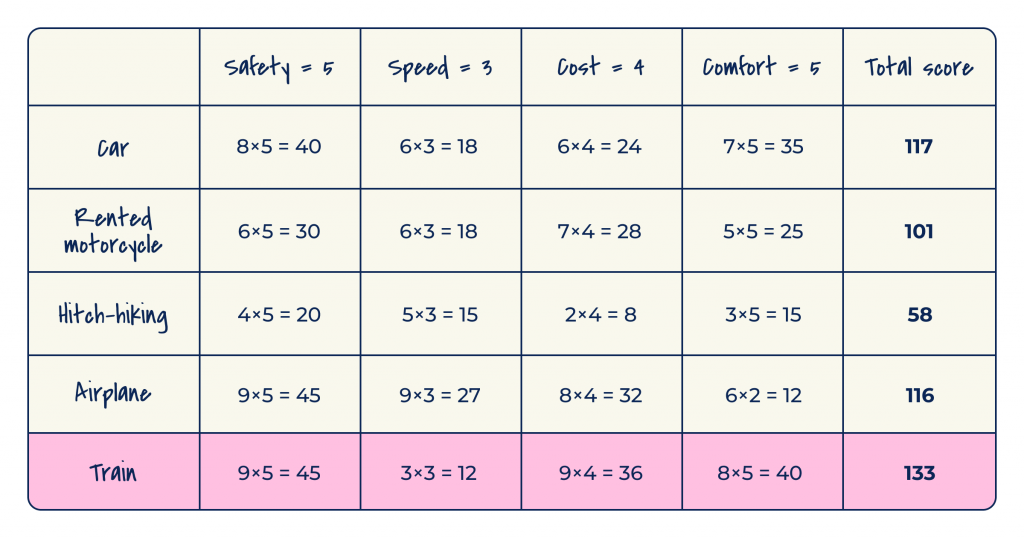
The last step was to add all the numbers in each line to get a total score. For instance, the total score of the Train option was 45+12+36+40 = 133, which is the biggest score in the table.
| Decision Matrix advantages | Decision Matrix limitations |
|---|---|
| Unbiased process. The Decision Matrix is based on the calculations that exclude biases from the investigated context. | Might get too complex and tiring. When choosing, let’s say, a fridge, you can have too many criteria and too many options. In this case, the decision-making session would take too much effort and time. |
| Based on logic. The framework allows comparing all options and prioritizing evaluating criteria so that you compare the most critical things. | Excludes intuition. While being totally logical and unbiased, the framework excludes personal preferences, desires, and intuition. Imagine your dream is to cross the country on a motorbike, then all the arguments for an airplane are useless. |
| Provides the solution. Unlike the previous framework, the Decision Matrix helps you make the final decision and choose one solution. | You choose among known options. To apply the Decision Matrix, we need to have options to choose from. Basically, we compare solutions but can’t create a new one with this tool. |
| Can only be used if the necessary data is available. If you compare multiple options but lack some information, the Decision Matrix framework won’t work. |
BRIDGeS framework
BRIDGeS is a versatile framework developed by the Railsware team. The framework is the result of our constant search for a universal tool to collect, analyze, and structure complex contexts of any subject.
Before BRIDGeS, we used to apply various discovery tools and frameworks to solve issues, ideate products, form strategies, etc. However, none of the known solutions were versatile enough. BRIDGeS has combined all the best from those solutions to help you handle complexity, set priorities, and solve your business or personal problem in just one session.
This decision-making framework is based on a 4-step process of multi-context analysis. During this process, you need to investigate the Benefits, Risks, Issues, Domain knowledge, and Goals of the main Subject to find an optimal Solution.
To run a BRIDGeS session, you’ll need a whiteboard, colored stickers, and markers, or you can use a free ready-made Figma template.
Here’s what you need to do in a BRIDGeS session:
- Describe the problem. Describe the problem. Start with defining the Subject(s) – someone or something that will benefit from solving a problem. When the Subject(s) is defined, analyze and write down its descriptors: Benefits, Risks, Issues, Domain knowledge, and Goals. All these elements should have their own color to facilitate the visual perception of the context.
- Prioritize the descriptors. Some problems are extensive and you’ll need to concentrate on the most important parts first, you may not have resources to address it in full. To note which problem aspects require the most focus, you can use multiple techniques. We recommend the MoSCoW method that we commonly use for product feature prioritization. According to the method, you should categorize descriptors into Must-haves, Should-haves, Could-haves, and Won’t-haves.
- Listing Solution variations. When you see all the most important descriptors of the problem being listed and prioritized, you will already have some potential direction of solutions in mind. If it’s unclear which direction (Solution variation) wins, you can analyze each using the same descriptors that you used to analyze Subject(s) to understand which solution variation best suits your situation. If you need to make a decision about solution variation, you can stop here. If you need a detailed implementation plan of your solution, then the next step is necessary.
- Break down the solution. Decompose your potential solution variation into smaller parts so that it covers all the high-priority descriptors (e.g. Benefits, Risks, Issues) that we identified at step 1. When you analyze the solution at the implementation level, these solution parts, in turn, could be decomposed into even smaller tasks. Prioritize these solution parts and tasks to plan their execution in one or several rounds. This is your roadmap for the solution implementation.
Now, let’s get back to our example. Our traveler from San Francisco is the Subject. The main Goal of the Subject is to spend a weekend in LA with a friend (shown in blue). As for the Benefits (light green), we listed affordability, schedule flexibility, comfort, flexible navigation in LA, and minimal travel time. We also mentioned that it’s hard to navigate in LA without a car as a Risk (yellow) and that driving that far is tiring – Domain knowledge (purple).
To see what aspects are the most critical, we prioritized them using the MoSCoW method.
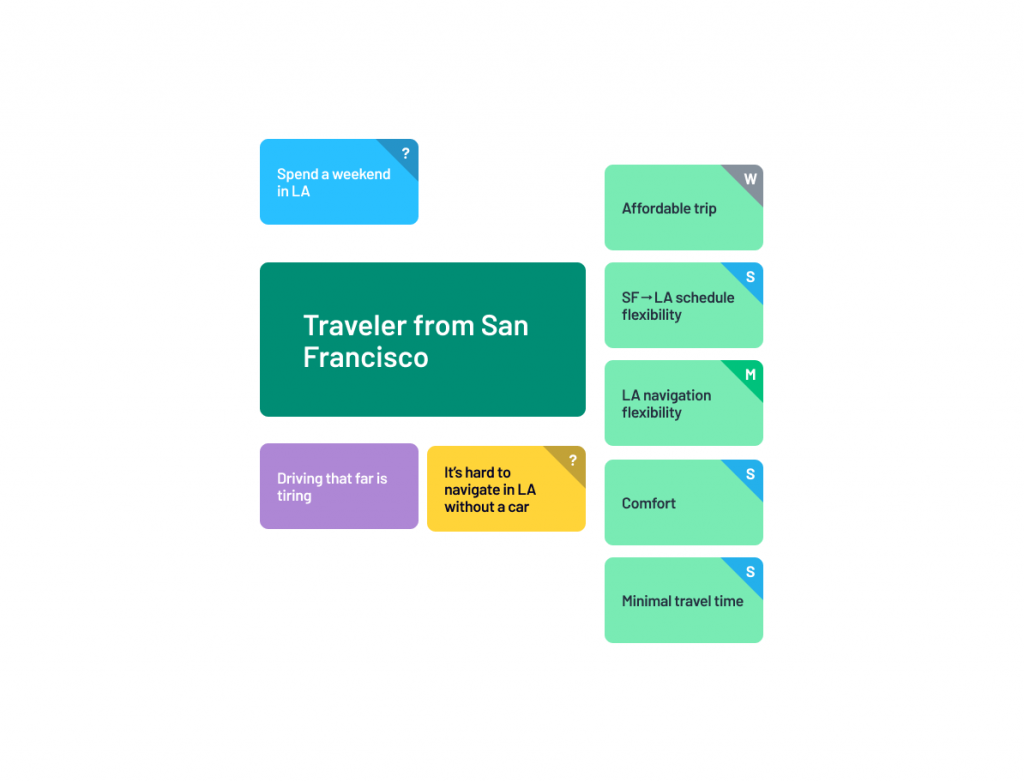
When the descriptors were ready, we came up with three potential options (Solution variations) that can satisfy the Traveler’s needs. These are an airplane, a car, and public transportation.
Now, it seems that the car is the best option because the Traveler won’t need to rent a car in LA. However, we wanted to make this example look like a real-life situation and imagined that the Traveler’s friend already has a car.
Looking at our board in a new light, we may conclude that an Airplane is more suitable. But what if our Traveler is afraid to fly? Well, it makes things even more complicated. Let’s apply the framework recursively and define the Benefits, Risks, and Issues of each Solution variation the same way we did for the Subject.
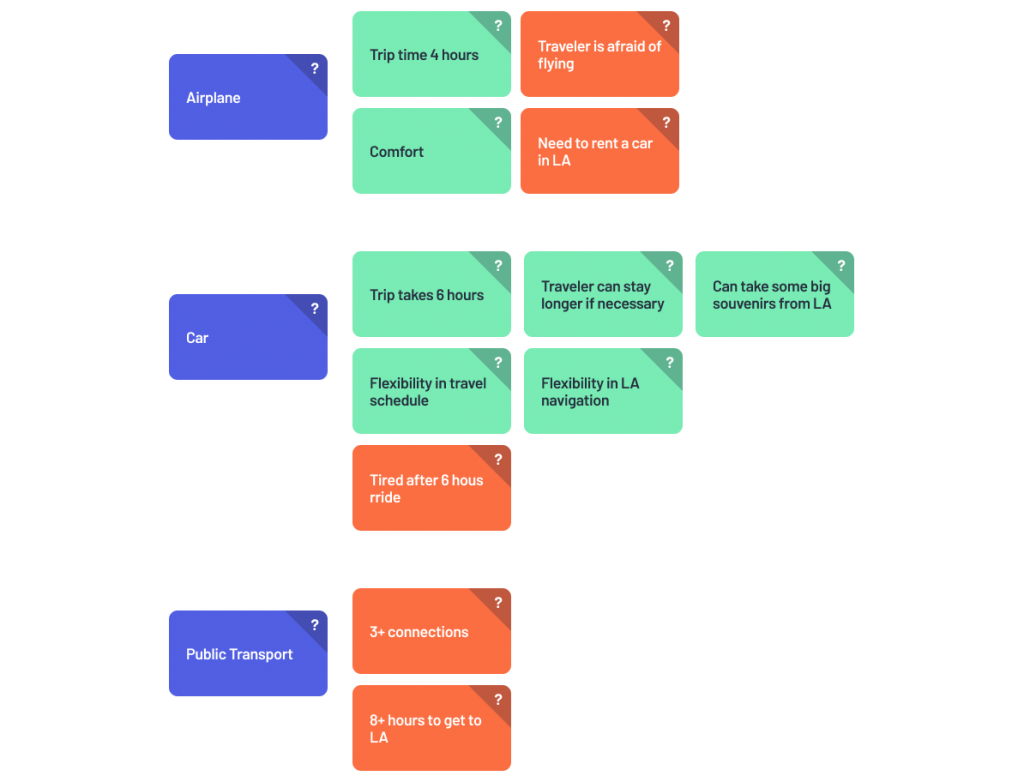
This decomposition allows us to see that the solution variation “Public transport” doesn’t provide any benefits. Despite its pros, the option “Airplane” can’t be considered as the Traveler is afraid to fly. The option “Car” has an issue – long and tiring ride, but it also has a list of advantages and meets most of the Traveler’s critical needs.
You can see more BRIDGeS use cases here.
| BRIDGeS advantages | BRIDGeS limitations |
|---|---|
| Allows both choosing and generating a new solution. The framework is equally great to make a choice when you have multiple options and when you need to create a brand new one. | Can be biased if there’s no research in advance. When dealing with a business-related context, it's better to start with an in-depth study involving specialists from different areas to understand the accurate picture better. Otherwise, all the arguments will be based on your personal assumptions. |
| Implementation plan as a result of a session. Unlike any other framework, BRIDGeS allows you to create an action plan to implement the solution you’ve come up with. | Is too bulky if you have a lot of similar choices. In case you need to choose one option from many similar variants (like when you choose a TV), the BRIDGeS framework isn’t the best tool for that. All the options have very similar characteristics that would make the context even more complex and overwhelming. |
| Allows managing complex context. Various descriptors let you analyze the problem and solutions comprehensively from different angles. | |
| Has a clear structure and instruction for the session. The framework has a well-structured flow that is easy to follow. There’s also a free, ready-to-use Figma template that you can use to save your time. | |
| Helps investigate each option to choose the most optimal one. BRIDGeS gives you a simple yet powerful tool to examine your variants so that you can make a well-balanced decision. | |
| Good to validate ideas before implementation. When you define all issues and potential risks of a particular solution, you can see if the option is viable, saving your time, money, and nerves. |
Cynefin framework
This tool was firstly introduced by Dave Snowden, an IBM Global Services management consultant, in 1999.
When applying the Cynefin decision-making framework to a problem, the first and main step would be to sort it into one of five categories. The further decision-making is based on the category a problem was classified to. Here are the problem categories and ways to solve them:
- Simple. These are stable situations with clear cause-and-effect relationships. Such problems are understandable to all involved, and the right answer is often self-evident. Snowden recommends solving such issues using some best practices.
- Complicated. Problems classified as complicated usually have a clear relationship between cause and effect but may have multiple right solutions. To solve these issues, you need to contact a domain expert.
- Complex. The cause of these issues is usually unclear. They are the result of unpredictable events with lots of unknowns, such as the economy, politics, weather, etc. The best way to address these challenges is to find a reversible solution that allows you to shift things around and have several backup plans, just in case.
- Chaotic. These are the problems with unknown causes and effects which happen during sudden crises, disasters, epidemics, etc. Often, these events are accompanied by panic and chaos, so searching for the right plan would be a waste of time. The main strategy in such conditions is to react fast and plug the biggest holes to minimize damage.
- Disorder. This is a problem that is difficult to classify into any previously mentioned category. These are usually large contexts that need to be split into smaller issues and handled one by one.
If we consider our example, imagine a situation when you opted for a car to get to LA, and a problem appeared on the drive.
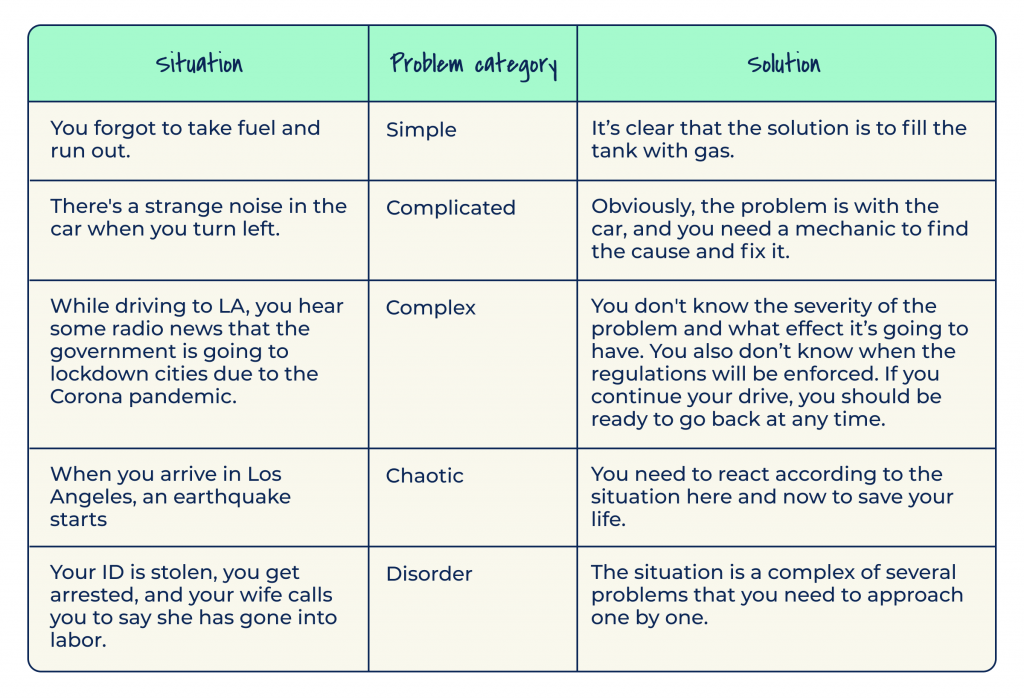
| Advantages | Limitations |
|---|---|
| Logical approach that simplifies the decision-making process. The framework helps you classify the problem and its severity and provides a tactic to solve it in the given conditions. | There’s a risk of placing a problem in the wrong category. The solution offered by the framework could mislead you in the wrong direction if the problem was identified incorrectly. |
| Helps find the starting point. When a crisis happens, it gets very difficult to make sensible decisions. The Cynefin framework allows finding the launchpad to start from. | The offered tactics don't always work. For instance, if recognized as simple, a problem should be solved according to the best practice. However, best practices get outdated and can’t guarantee you the best outcome. |
| Excludes innovations. If the problem is Complicated, a leader might narrow down the team to only experts, excluding people who can offer a fresh perspective. | |
| May waste valuable time. If recognized incorrectly, you can lose valuable time and even worsen the situation. |
Xanax for decision-making
This relatively new tool was introduced by Gil Shklarski, a CTO at Flatiron Health in the past and an experienced startup mentor. When working at Flatiron Health, Gil noticed that many talented specialists didn’t want to enter C-level positions. They were wary of the high pressure connected with decision-making and negotiating these decisions with colleagues.
Gil Shklarski’s tool focuses on reversible decisions and the fact that almost all decisions can be reversible. Also, the framework allowed easily justifying each decision to colleagues, making them clear and transparent. Here’s how it works.
Xanax for decision-making resembles a simple chart with the pros and cons of a certain solution but has a slight modification that changes the perspective. Using this decision-making framework, you need to consider each option and list their Benefits, Costs, and Mitigations. The additional dimension (Mitigation) simplifies decision-making by showing how to make each decision reversible, if it’s possible, of course, or how to neutralize the costs in advance.
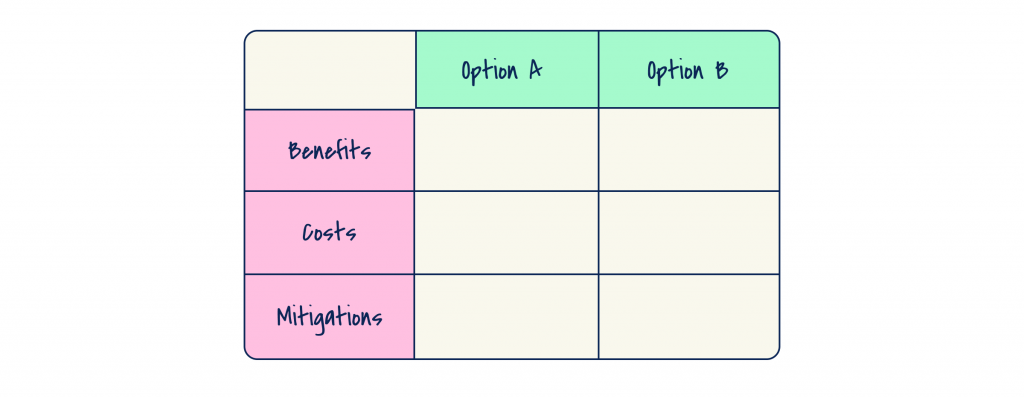
When a table is created and all options are discussed, a team makes a decision and freezes it for 24 hours. It helps to release tension, check the data again, and weigh all the consequences of a selected solution.
Now, let’s apply this tool to our example.
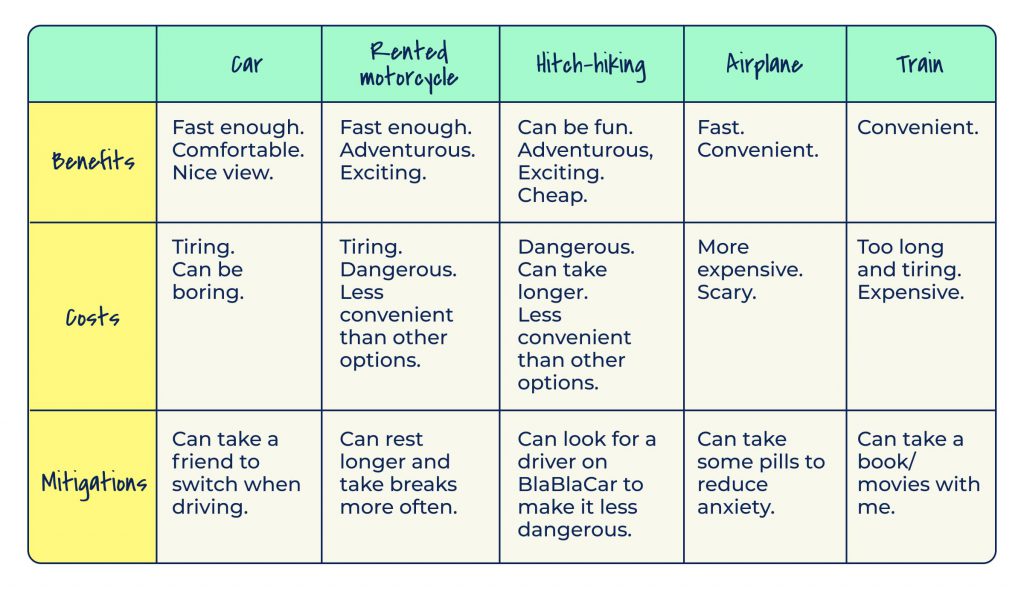
Using the framework, we get a list of tradeoffs and can make a decision knowing what things we can or can’t compromise. When applied to a business-related area, a decision-maker sees if all risks of the chosen option can be mitigated and at what costs.
| Advantages | Limitations |
|---|---|
| Helps to find a reversible decision. This benefit is especially crucial for businesses where a chosen path may need to be changed rapidly. | Can’t be used when a new solution should be generated. Similar to the Decision Matrix, Xanax for decision-making is only good when you’re making a choice among multiple existing options. |
| Allows detecting and weighing the risks. The traditional list of pros and cons doesn’t help you prioritize risks and see which one is more difficult to mitigate. | Can be tricky if you don’t know all the potential risks. If you can’t identify the potential risks of each option, your judgments will be clouded. |
| Helps find mitigations for the risks. You see the depth of each risk and find the ways to solve them if it's possible. | Doesn’t help in making non-reversible decisions. If you need to make a non-reversible decision, this framework won't provide enough context. |
| Helps communicate decisions to a team. The tool allows explaining the motivation behind each decision so that a team understands why you made this or that choice. | Doesn’t help in urgent situations. The application of this framework requires a team to have a 24-hour break which is not possible in some urgent or emergency situations. |
| Gives confidence. Unlike some other decision-making frameworks, with this one, you are sure that you've chosen an optimal decision and that you can easily fix everything if something goes wrong because you’ve already thought this through. | |
| A 24-hour break releases tension. The break is necessary to dot all the i's and cross all the t's. |
Dimensionality reduction
The framework is widely used in statistics, computer science, and machine learning. It is based on the idea of simplification and narrowing down your focus to the most important things. Unlike the Decision Matrix, where you had to collect comprehensive data on the options, here, you need to hew off everything that is non-critical. Here’s how it works:
- List all your options and criteria (dimensions) you can use for comparison.
- Write out all the dimensions that you can compromise.
- Set the limit for each dimension if possible. It can be the lowest or highest value, depending on a criterion. For instance, if you’re choosing a new job and considering Salary as a crucial dimension, you need to think of the minimum sum that is acceptable for you.
- Prioritize dimensions in relation to each other. Even the most critical dimensions would still have different values.
Now, let’s use the framework in our example.
First, we listed all the options and their dimensions. Then, we decided that Cost isn’t very important and we can ignore this criterion completely. We colored this column red to visually distinguish the dimensions.
The dimensions Speed and Excitement aren’t critical for us, but we decided to keep them in our table. We colored them yellow.
Safety and Comfort are the most decisive criteria. We colored them green.
The next step would be to estimate the dimensions using some quantitative indicators. In our case, we don’t have a metric system for our criteria so we used a five-mark grading system. We also need to set a limit for different criteria if we don’t necessarily need them to reach the upper bound. For instance, the accepted value for Safety and Comfort can be 4.
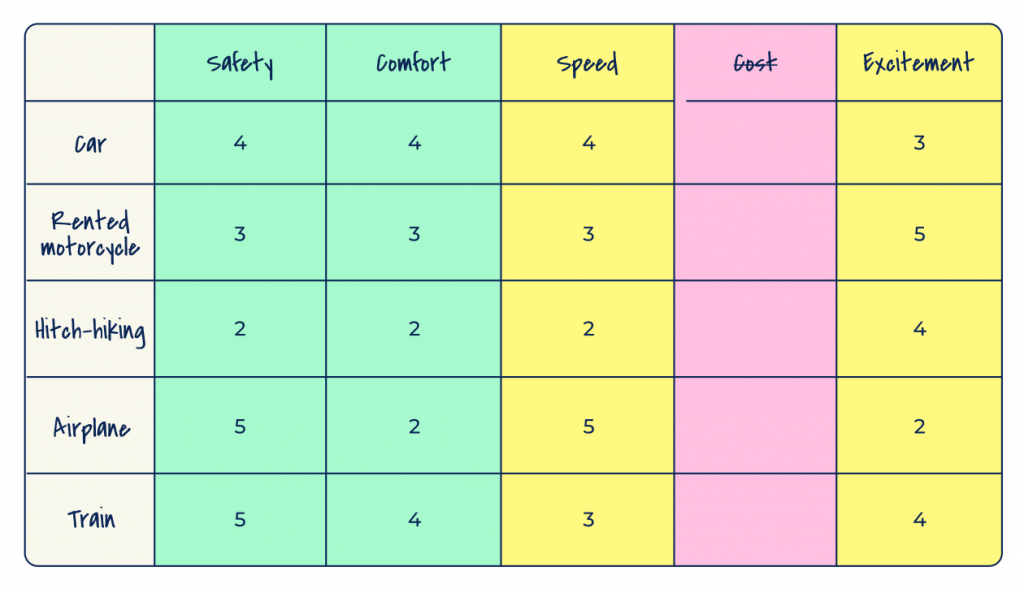
To analyze the results, we need to focus on the most critical dimensions, ignoring less important ones. For instance, Airplane is the fastest option, and a Motorcycle is the most exciting one, but we won’t opt for them because our task is to focus on Safety and Comfort.
| Advantages | Limitations |
|---|---|
| Allows handling the complexity. In cases when there are too many similar options with too many dimensions available, this framework is perfect for sorting things out. | You have to give up on everything that is not vital when ignoring dimensions. This exercise is tricky because you exclude emotions here and think logically about dimensions. While some decisions should be based on emotions, or at least take them into account. |
| Helps to focus on what’s the most important. When writing out dimensions, you reduce your chances of being blinded by secondary criteria. | The framework is only good when you have multiple options with similar characteristics. You can’t use this tool if there are only two options or if all options have different criteria. |
| By setting limits within dimensions, you narrow down the choices even more. For instance, when choosing a TV, you can establish a size range of 33 to 60 inches to exclude hundreds of TV models from the equation. | Doesn’t give you the answer. The table you create is a great visual tool to set priorities and get a fresh look at your options. However, the final decision is not always obvious. |
WRAP framework
The WRAP framework was firstly introduced by Chip and Dan Heath in their book “Decisive: How to Make Better Choices in Life and Work.” WRAP is an abbreviation for the four steps the framework consists of: widen frames, reality test assumptions, attain detachment, prepare for failure.
These steps include several activities that help you comprehend the context and release you from the tension that is usually connected with decision-making. Here’s how the process looks like:
- Widen frames. This exercise challenges you to not focus on your problem but to go beyond it. The main question here is if it’s really the problem you’re trying to approach.
- Reality test assumptions. At this step, you need to take one potential solution and imagine how it would work in the future. Think about what can go wrong, and list all negative assumptions to get a sensible view of things.
- Attain detachment. To reduce tension, you can distance yourself from the decision-making process and imagine what your friend (if the context is personal) or another specialist (if the context is professional) would do in this situation.
- Prepare for failure. Now, imagine your decision failed. What would you do to fix it? Think about lines of withdrawal to mitigate the consequences and how you can get back to the starting point at minimum expense.
Here’s how it would work in our example when you need to travel from San Francisco to Los Angeles.
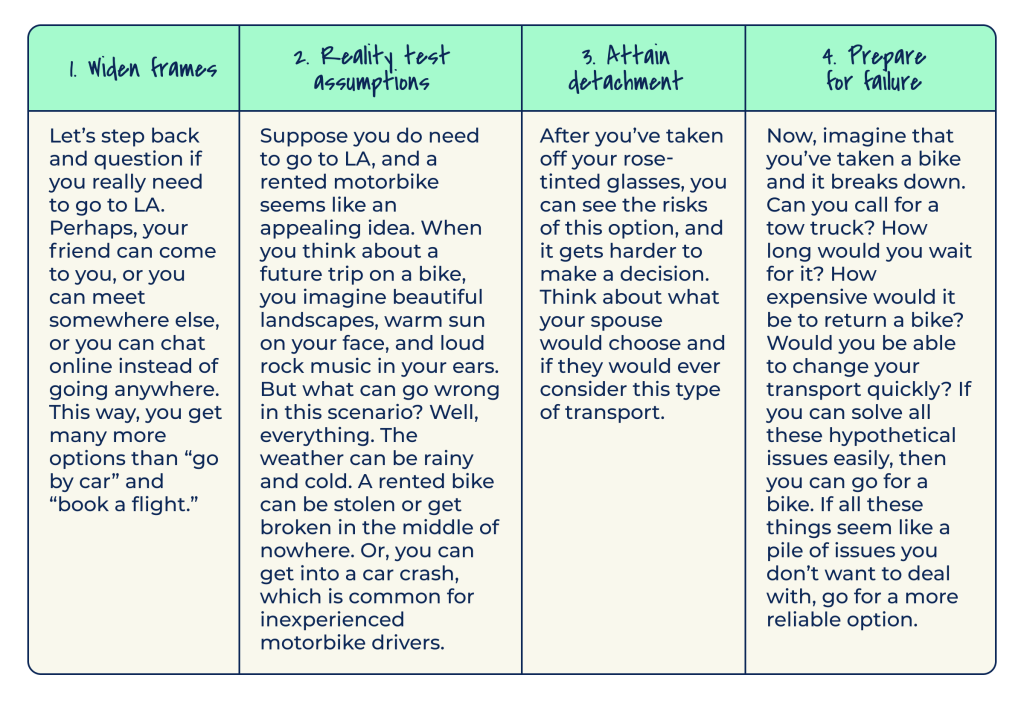
| WRAP advantages | WRAP limitations |
| Helps widen horizons and find a better solution or realize that you don’t need to solve this problem at all. | Doesn’t have a structured flow that leads to one option. During your brainstorming session, you can come up with dozens of great options which are difficult to compare. |
| Allows you to find a new, uncommon solution or create a new one. The framework is good at making new solutions, looking for unusual approaches and tools. | You still need to make a decision. The framework is good for validating each option, but it doesn’t provide you with an optimal decision. You need to make it on your own. |
| Releases tension when making decisions. The framework makes decision-making much easier when you know how to mitigate the consequences of your decision and when considering how others would approach this problem. | The results of different exercises can be controversial. You may come up with a great company strategy that you know other managers would reject. In this case, the pressure gets even higher. |
| Requires a long time for data collecting and contemplating. Considering each option one by one, you may spend a lot of time making a final choice. |
Wrapping up
All the decision-making frameworks we’ve considered in this post work great. However, it’s impossible to compare them and select the best one as they all serve different purposes and suit different situations.
For instance, if you need to choose among multiple similar options with various characteristics, we’d recommend the Dimensionality reduction framework.
Use Xanax for decision-making if you need to make a decision that is hard to communicate to your colleagues.
In case of an emergency, or if you don’t know how to solve your issue at all, Cynefin problem classification will help you find a starting point.
To compare multiple options without emotions, opt for the Decision Matrix.
And if you need to not only create a new solution but also get an actionable plan for its implementation, then the BRIDGeS framework can be your best shot.
